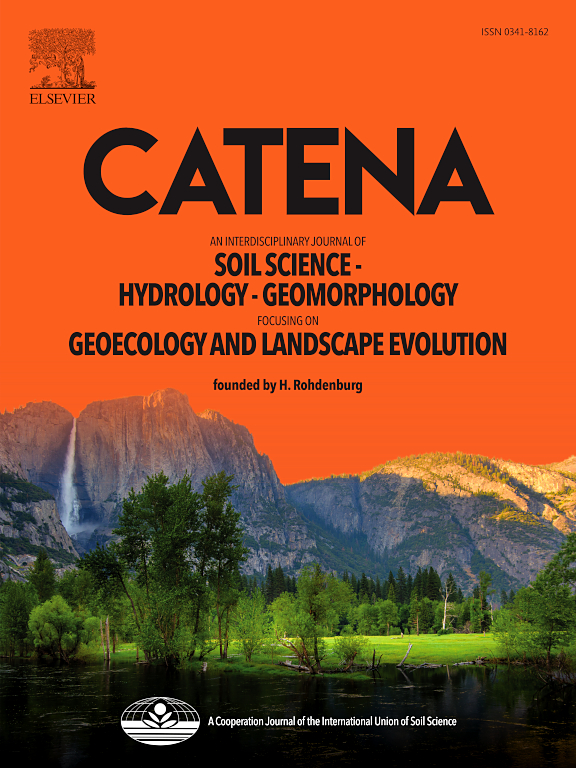Sediment and soil source apportionment using geochemical fingerprinting techniques in the Winam Gulf, Lake Victoria
IF 5.4
1区 农林科学
Q1 GEOSCIENCES, MULTIDISCIPLINARY
引用次数: 0
Abstract
Accelerated soil erosion is a major cause of land degradation in East Africa’s agricultural and pastoral landscapes with severe consequences for food, water and livelihood security. In this study, we aimed to provide a tool to support the sustainable management of land and water resources in a region significantly impacted by land degradation. We employed source apportionment methods to quantify the relative contribution of sediment sources within the Nyando and Sondu-Miriu River basins and their subcatchments in the Winam Gulf, Kenya. A total of 237 riverbed sediment samples and 76 composite surface soil samples were collected from the Nyando and Sondu-Miriu River basins. The total elemental concentrations of these samples, determined using ICP-MS/MS, were utilised as geochemical tracer properties. Conservativeness index, consensus ranking and consistent tracer selection methods were then used to identify the optimum unmixing tracers before applying the frequentist unmixing model FingerPro to determine sediment provenance. Sediment source analysis revealed that the Ainamutua and Nyando-Kipchorian subcatchments, areas predominantly affected by land degradation activities such as poor crop management practices and deforestation on steep slopes, contributed 39 ± 4 % and 44 ± 4 %, respectively. In contrast, the Awach Kano and Nyaidho subcatchment, with a higher proportion of tree-cover and lower soil erosion rates, only contributed 17 ± 7 %. In the Sondu-Miriu, the Yurith and Kipsonoi subcatchments contributed 68 ± 5 % and 20 ± 6 %, respectively, due to the predominance of forest encroachment and ridges in the Yurith subcatchment. Additional fingerprinting analysis within each of the Nyando and Sondu-Miriu basins reveals the significance of land use, landform and soil types on source contributions. Quantifying sediment source contributions within large river basins provides essential information for environmental managers and policymakers developing integrated catchment management plans. The results from this study can be used to implement sustainable land use policy focused on soil restoration in the Lake Victoria drainage basin.

利用地球化学指纹技术对维多利亚湖温南湾沉积物和土壤源进行分析
加速的土壤侵蚀是造成东非农业和畜牧业土地退化的主要原因,对粮食、水和生计安全造成严重后果。在本研究中,我们旨在为受土地退化严重影响的地区提供一种支持土地和水资源可持续管理的工具。我们采用源分配方法来量化肯尼亚温南湾Nyando和Sondu-Miriu河流域及其子集水区沉积物源的相对贡献。在年都河和顺都-三留河流域共采集了237个河床沉积物样本和76个复合表层土壤样本。这些样品的总元素浓度采用ICP-MS/MS测定,作为地球化学示踪剂性质。然后采用保守指数法、共识排序法和一致示踪剂选择法确定最佳解混示踪剂,然后应用频率解混模型FingerPro确定沉积物物源。沉积物来源分析显示,Ainamutua和Nyando-Kipchorian亚集水区分别贡献了39±4%和44±4%,这两个地区主要受土地退化活动(如作物管理不善和陡峭山坡上的森林砍伐)的影响。相比之下,树木覆盖率较高、土壤侵蚀率较低的Awach Kano和Nyaidho子集水区仅贡献了17±7%。在Sondu-Miriu, Yurith和Kipsonoi亚集水区分别贡献了68±5%和20±6%,这是由于Yurith亚集水区以森林侵蚀和山脊为主。对Nyando和Sondu-Miriu盆地的指纹分析揭示了土地利用、地貌和土壤类型对来源贡献的重要性。量化大型河流流域内沉积物来源的贡献为环境管理者和决策者制定综合流域管理计划提供了必要的信息。研究结果可为维多利亚湖流域实施以土壤恢复为重点的可持续土地利用政策提供依据。
本文章由计算机程序翻译,如有差异,请以英文原文为准。
求助全文
约1分钟内获得全文
求助全文
来源期刊

Catena
环境科学-地球科学综合
CiteScore
10.50
自引率
9.70%
发文量
816
审稿时长
54 days
期刊介绍:
Catena publishes papers describing original field and laboratory investigations and reviews on geoecology and landscape evolution with emphasis on interdisciplinary aspects of soil science, hydrology and geomorphology. It aims to disseminate new knowledge and foster better understanding of the physical environment, of evolutionary sequences that have resulted in past and current landscapes, and of the natural processes that are likely to determine the fate of our terrestrial environment.
Papers within any one of the above topics are welcome provided they are of sufficiently wide interest and relevance.
 求助内容:
求助内容: 应助结果提醒方式:
应助结果提醒方式:


